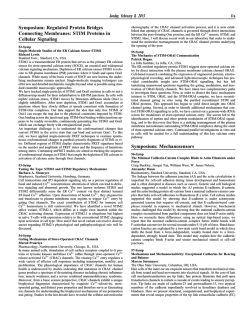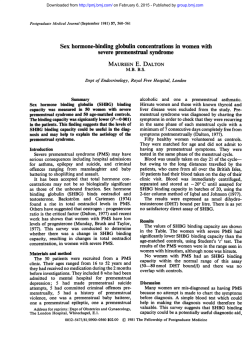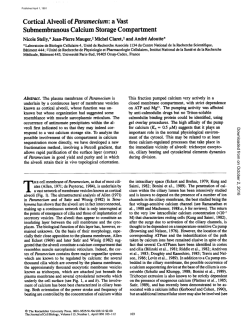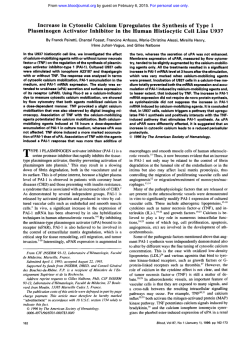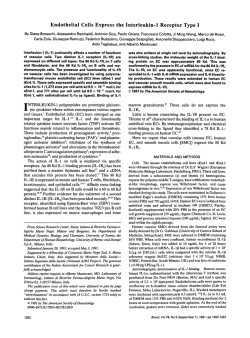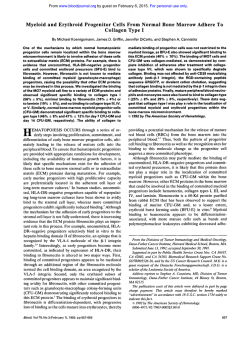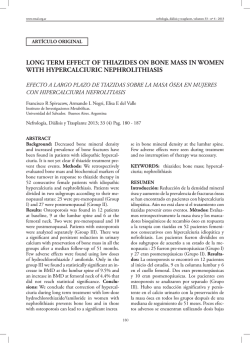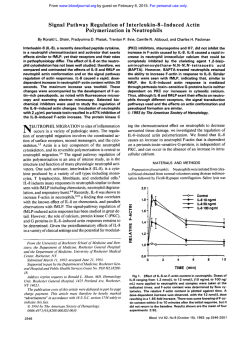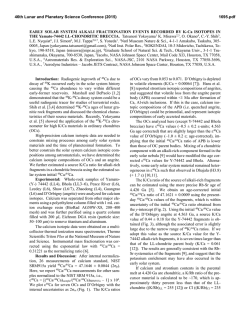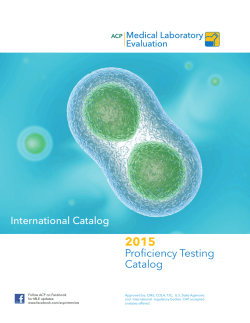
Mechanisms and Mechanosensitivity: Exceptional Cadherins
Sunday, February 8, 2015 Symposium: Regulated Protein Bridges Connecting Membranes: STIM Proteins in Cellular Signaling 52-Symp Single-Molecule Studies of the ER Calcium Sensor STIM1 Richard Lewis. Stanford Univ., Stanford, CA, USA. STIM1 is a transmembrane ER protein that serves as the primary ER calcium sensor for store-operated calcium entry (SOCE), an essential and widespread calcium signaling mechanism. Depletion of ER calcium causes STIM1 to relocate to ER-plasma membrane (PM) junctions where it binds and opens Orai1 channels. While many of the basic events of SOCE are now known, the underlying mechanisms remain unclear. Single-molecule imaging techniques can offer new and detailed mechanistic insights beyond what is possible using standard ensemble macroscopic approaches. We have tracked single particles of STIM1 and Orai1 proteins in cells to test a diffusion-trap model for their redistribution to ER-PM junctions. In cells with replete calcium stores, STIM1 moves by Brownian diffusion while Orai1 is slightly subdiffusive. After store depletion, STIM1 and Orai1 accumulate at junctions where they slowly diffuse at speeds consistent with formation of STIM-Orai complexes. Our data support the idea that only free STIM1 or Orai1 can escape the trap due to the physical constraints imposed by STIMOrai binding across the junctional gap. STIM-Orai binding within junctions appears to be readily reversible, continuously generating free STIM1 and Orai1 which can exchange freely with extrajunctional pools. An important challenge is to understand the conformational changes that convert STIM1 to the active state that can bind and activate Orai1. To this end, we have applied single-molecule FRET techniques to examine spontaneous conformational changes in purified cytosolic fragments of STIM1 in vitro. Different regions of STIM1 display characteristic FRET signatures based on the number and amplitude of FRET states and the frequency of transitions among states. Continuing smFRET studies are aimed at tracking the sequence of conformational changes in STIM1 that couple the depletion of ER calcium to activation of calcium entry through Orai channels. 53-Symp Tuning the Taps: STIM1 and STIM2 Regulatory Mechanisms Barbara A. Niemeyer. Biophysics, Saarland University, Homburg, Germany. Cell homeostasis and IP3 dependent signaling rely on a precise regulation of basal and induced Ca2þ concentrations; alterations of which can lead to defective signaling and abnormal growth. The two known isoforms STIM1 and STIM2 differentially sense the ER Ca2þ content via their distinct luminal EF-hand Ca2þ affinities. Upon dissociation of bound Ca2þ, they oligomerize and translocate to plasma membrane near regions to trigger Ca2þ entry by gating Orai channels. The exact contribution of STIM2 for immune cell Ca2þ homeostasis is still controversial. We have identified a novel STIM2 splice variant, STIM2.1, which differs in a single exon inserted within the CRAC activating domain. Expression of STIM2.1 is ubiquitous but highest in naı¨ve T-cells with expression relative to the conventional STIM2 changing upon activation or cell type. How and if this novel variant can resolve discrepancies regarding STIM2’s physiological and pathophysiological role will be discussed. 54-Symp Gating Mechanisms of Store-Operated CRAC Channels Murali Prakriya. Pharmacology, Northwestern University, Chicago, IL, USA. In many animal cells, stimulation of cell surface receptors coupled to G proteins or tyrosine kinases mobilizes Ca2þ influx through store-operated Ca2þ release-activated Ca2þ (CRAC) channels. The ensuing Ca2þ entry regulates a wide variety of effector cell responses including transcription, motility, and proliferation. The physiological importance of CRAC channels for human health is underscored by studies indicating that mutations in CRAC channel genes produce a spectrum of devastating diseases including chronic inflammation, muscle weakness, and a severe combined immunodeficiency syndrome. Moreover, from a basic science perspective, CRAC channels exhibit a unique biophysical fingerprint characterized by exquisite Ca2þ-selectivity, storeoperated gating, and distinct pore properties and therefore serve as fascinating ion channels for understanding the biophysical mechanisms of ion permeation and gating. Studies in the last decade have revealed the cellular and molecular 11a choreography of the CRAC channel activation process, and it is now established that opening of CRAC channels is governed through direct interactions between the pore-forming Orai proteins, and the ER Ca2þ sensors, STIM1 and STIM2. Here, I will discuss recent work in our laboratory that seeks to understand the molecular rearrangements in the CRAC channel protein underlying the opening of the pore. 55-Symp The Mechanics of STIM-ORAI Communication Patrick Hogan. La Jolla Institute, La Jolla, CA, USA. The ER-resident regulatory protein STIM1 triggers store-operated calcium entry by direct interaction with the plasma membrane calcium channel ORAI1. Cell-based research combining the expression of engineered proteins, electrophysiological recording, and advanced light-microscopic techniques has provided considerable insight into STIM-ORAI signalling, but has left tantalizing unanswered questions regarding the gating, modulation, and inactivation of ORAI-family channels. We have taken two complementary paths to investigate these questions. First, in order to dissect the basic mechanisms intrinsic to STIM, ORAI, and the STIM-ORAI complex, we have reconstituted channel gating in vitro using the purified recombinant STIM and ORAI proteins. This approach has begun to yield direct insight into ORAI channel gating. Second, in order to identify additional mechanisms that control STIM-ORAI signalling in cells, we have carried out a genome-wide RNAi screen for modulators of store-operated calcium entry. The screen led to the identification of septins and other protein modulators of STIM-ORAI signalling, and to the discovery that there is a striking rearrangement of the plasma membrane microdomain surrounding STIM-ORAI complexes during the onset of store-operated calcium entry. Continued parallel investigations in vitro and in cells will be needed for a full understanding of this key calcium entry pathway. Symposium: Mechanosensors 56-Symp The Minimal Cadherin-Catenin Complex Binds to Actin Filaments under Force Craig Buckley, Jiongyi Tan, William Weis, W. James Nelson, Alexander Dunn. Biochemistry, Stanford University, Stanford, CA, USA. The linkage between the adherens junction (AJ) and the actin cytoskeleton is important for cell-cell adhesion during tissue development and homeostasis and is often disrupted in diseases such as cancer. Genetic and cell biological studies suggested a model in which the AJ proteins E-cadherin, b-catenin, and the actin binding protein aE-catenin form a minimal cadherin-catenin complex that links cell-cell adhesions to filamentous (F-) actin. Cell culture studies supported this model by showing that E-cadherin is under actomyosingenerated tension that requires aE-catenin, and that E-cadherin-based complexes remodel in response to mechanical stimuli. However, biochemical studies challenged this model by showing that the minimal cadherin-catenin complex reconstituted from purified components does not bind F-actin stably. Here we reconcile these differences: using an optical trap-based assay, we report that the minimal cadherin-catenin complex forms stable bonds with F-actin that can survive for several seconds under 5-15 pN of force. Bond dissociation kinetics are explained by a two-state catch bond model in which force shifts the bond from a force-independent, weakly bound state to a forcedependent, strongly bound state. This model may explain how the cadherincatenin complex binds F-actin and senses mechanical stimuli at cell-cell junctions. 57-Symp Mechanisms and Mechanosensitivity: Exceptional Cadherins for Hearing and Balance Marcos Sotomayor. The Ohio State University, Columbus, OH, USA. Hair cells of the inner ear are exquisite sensors that transform mechanical stimuli from sound and head movements into electrical signals. At the core of hair cell mechanotransduction are tip links, fine protein filaments that pull open transduction channels to initiate a cascade of events leading to sensory perception. Tip links are made of cadherin-23 and protocadherin-15, two atypical members of the cadherin superfamily involved in hereditary deafness and blindness. Here we present structural, computational, and biophysical experiments that reveal unique properties of the tip link extracellular cadherin (EC) 12a Sunday, February 8, 2015 repeats. Our crystal structures, simulations, and binding assays show how the tip of protocadherin-15 and some of its variants form a mechanically strong and calcium-dependent heterophilic complex with the cadherin-23 tip. In addition, structures and simulations of protocadherin-15 EC repeats show how noncanonical linker regions may alter protocadherin-15’s tertiary structure and elasticity. Overall, our results provide a molecular view of tip link mechanics and identify the molecular determinants of tip link function in vertebrate mechanosensation. 58-Symp Mechanical Forces in B cell Activation Pavel Tolar. MRC National Institute for Medical Research, London, United Kingdom. The generation of protective antibodies depends on the selective expansion of B cells with the strongest binding of their B cell receptors (BCRs) to foreign antigens. This process starts by formation of B cell immune synapses with antigen-presenting cells. BCR signaling in immune synapses triggers extraction of the antigens, leading to B cell antigen processing and presentation to helper T cells - a step that ultimately controls the relative expansion of B cell clones. To internalize antigen from immune synapses, B cells generate tensile forces by activating the non-muscle myosin IIa. Myosin contractility invaginates synaptic antigen clusters and promotes antigen internalization by clathrin-mediated endocytosis. Forces generated by myosin IIa in B cell synapses rupture low avidity interactions between the BCR and antigens and provide thus a negative feedback to BCR antigen binding and signaling, which promotes B cell affinity discrimination. These results suggest that B cells use mechanical forces to test the strength of antigen binding to the BCR. The location, intensity and timing of the forces are distinctly regulated in B cell subsets. In naive B cells, antigen clusters form and grow in lamellipodia, move centripetally and are collected in the center of the synapse. Tensile forces are applied at the base of lamellipodia, creating a delay that allows cluster growth, increase in cluster avidity and greater sensitivity of endocytosis. In contrast, germinal centre B cells, which undergo affinity selection, apply strong forces on small antigen clusters in the periphery of the synapse. This synaptic architecture of germinal center B cells is associated with higher stringency of affinity discrimination. Thus, B cell selection is regulated by the architecture of immune synapses through the coordination of signaling, contractility and endocytosis. 59-Symp Navigating a Maze - Sensing and Responding to Mechanical Obstacles during Cellular Invasive Growth Carlos Agudelo1, Amir Sanati Nezhad1, Mahmood Ghanbari1, Muthukumaran Packirisamy1, Anja Geitmann2. 1 Concordia University, Montreal, QC, Canada, 2University of Montreal, Montreal, QC, Canada. The tool delivering the sperm cells in the flowering plants, the pollen tube, has to invade multiple tissues to reach its target within the pistil, the female gametophyte. To accomplish this task the rapidly growing tube must perceive the geometry and mechanical consistency of the growth substrate as well as directional cues guiding it towards the target. To penetrate the pistillar tissues the pollen tube also needs to produce invasive forces to overcome any mechanical impedance. To investigate the directional growth behavior, the role of chemical, mechanical and electrical guidance cues, and the ability to cope with mechanical obstacles we devised the TipChip, a microfluidic experimental platform that allows us to assess these parameters in quantitative manner. Pollen grains are trapped individually within the microfluidic network, and the germinating pollen tubes are guided into microchannels in which they are exposed to test assays such as calibrated micro-cantilevers, highly localized electrical fields, or micron-sharp chemical gradients. These approaches have enabled us to quantify the invasive and dilating force of growing pollen tubes, revealing that the tubes employ the internal turgor pressure to generate this force, but that they modulate it by regulating the cell wall mechanical properties. The use of precisely calibrated electrical fields has revealed that medium conductivity plays an important role in mediating the effect of the field on the cellular response. Finally, navigation in a chemical gradient seems to be governed by complex strategies that overlap and must be integrated depending on the nature of the cues provided. Our experiments illustrate that to fully understand the strategies governing pollen tube growth, in vitro studies must be rendered more relevant for the in vivo situation by simulating the micro-environment of the pistil. Platform: Molecular Simulation: Structure and Interactions 60-Plat Role of Desolvation in Thermodynamics and Kinetics of Ligand Binding to a Protein Jagannath Mondal, Richard Friesner, Bruce J. Berne. Chemistry, Columbia University, New York, NY, USA. Computer simulations are used to determine the free energy landscape for the binding of the anti-cancer drug Dasatinib to its src kinase receptor and show that before settling into a free energy basin the ligand must surmount a free energy barrier. An analysis based on using both the ligand-pocket separation and the pocket-water occupancy as reaction coordinates shows that the free energy barrier is a result of the free energy cost for almost complete desolvation of the binding pocket. The simulations further show that the barrier is not a result of the reorganization free energy of the binding pocket. Although a continuum solvent model gives the location of free energy minima, it is not able to reproduce the intermediate free energy barrier. Finally, it is shown that a kinetic model for the on rate constant in which the ligand diffuses up to a doorway state and then surmounts the desolvation free energy barrier is consistent with published very long time simulations of the ligand binding kinetics for this system [D. E. Shaw et al., J. Am. Chem. Soc. 2011, 133, 9181-9183] 61-Plat Insights into the Stabilizing role of Cholesterol for the Amyloid Precursor Protein Martina Audagnotto1, Matteo Dal Peraro2. 1 School of Life Sciences, Institute of Bioengineering, Ecole Polytechnique Fe´de´rale de Lausanne (EPFL), CH1015 Lausanne, Switzerland, 2School of Life Sciences, Ecole Polytechnique Fe´de´rale de Lausanne (EPFL), CH1015 Lausanne, Switzerland. The Amyloid Precursor Protein (APP) is a type-I transmembrane glycoprotein that is present in the synaptic plasma membrane (SPM). Its cleavage by g-secretase produces Ab amyloids, which are major components of the plaques observed in patients affected by Alzheimer disease (AD). In the last years, APP has been proposed to have both a monomeric and a homodimeric structures. In particular, two possible dimerization interfaces were proposed: namely, G(700)XXXG(704)XXXG(708) and G(709)XXXA(713) of which, as suggested by NMR and EPR experiments, the former can represent a cholesterol binding motif key for the stabilization of APP transmembrane domain. However, at today, there is no consensus on the role of these two motifs on the structural and dynamic properties of APP. In this study, we aim at dissecting, using atomistic molecular dynamics (MD) simulations and realistic models of the SPM the role of these binding motifs for the stability of APP transmembrane domain. Preliminary results show that cholesterol molecules have high affinity for both the G(700)XXXG(704) XXXG(708) and G(709)XXXA(713) motif, promoting the destabilization of the homodimeric APP structure. The molecular description of the APP dimerization dynamics at the SPM can have specific and important implications for g-secretase cleavage and the following production of amyloidogenic peptides related with AD. 62-Plat Pharmacophore Modeling using Site-Identification by Ligand Competitive Saturation (SILCS) Method with Multiple Probe Molecules Wenbo Yu, E. Prabhu Raman, Sirish Kaushik Lakkaraju, Lei Fang, Alexander D. MacKerell, Jr. Department of Pharmaceutical Sciences, University of Maryland, Baltimore, Baltimore, MD, USA. Receptor-based pharmacophore modeling is a computer-aided drug design technique that uses the structure of the target protein to identify novel ligands that may bind[1]. Typical receptor-based pharmacophore modeling methods are limited by the neglect of protein flexibility and desolvation effects, since only a single or limited number of receptor conformations are considered in the modeling which is usually performed in vacuum or with a limited representation of the aqueous solvent environment. The SILCS assisted pharmacophore modeling protocol (SILCS-Pharm)[2] was introduced recently to address these issues since SILCS[3] naturally takes both protein flexibility and desolvation effects into account by using full MD simulations to determine 3D maps of the functional group-binding patterns on a target receptor. In the present work, SILCS-Pharm protocol is extended to use a wider range of fragments including benzene, propane, methanol, formamide, acetaldehyde,
© Copyright 2025
